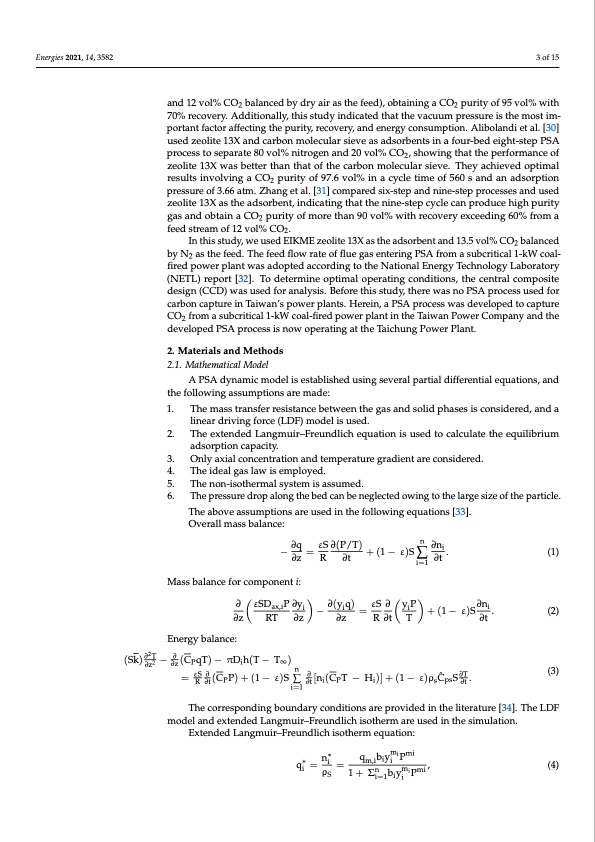
PDF Publication Title:
Text from PDF Page: 003
Energies 2021, 14, 3582 3 of 15 and 12 vol% CO2 balanced by dry air as the feed), obtaining a CO2 purity of 95 vol% with 70% recovery. Additionally, this study indicated that the vacuum pressure is the most im- portant factor affecting the purity, recovery, and energy consumption. Alibolandi et al. [30] used zeolite 13X and carbon molecular sieve as adsorbents in a four-bed eight-step PSA process to separate 80 vol% nitrogen and 20 vol% CO2, showing that the performance of zeolite 13X was better than that of the carbon molecular sieve. They achieved optimal results involving a CO2 purity of 97.6 vol% in a cycle time of 560 s and an adsorption pressure of 3.66 atm. Zhang et al. [31] compared six-step and nine-step processes and used zeolite 13X as the adsorbent, indicating that the nine-step cycle can produce high purity gas and obtain a CO2 purity of more than 90 vol% with recovery exceeding 60% from a feed stream of 12 vol% CO2. In this study, we used EIKME zeolite 13X as the adsorbent and 13.5 vol% CO2 balanced by N2 as the feed. The feed flow rate of flue gas entering PSA from a subcritical 1-kW coal- fired power plant was adopted according to the National Energy Technology Laboratory (NETL) report [32]. To determine optimal operating conditions, the central composite design (CCD) was used for analysis. Before this study, there was no PSA process used for carbon capture in Taiwan’s power plants. Herein, a PSA process was developed to capture CO2 from a subcritical 1-kW coal-fired power plant in the Taiwan Power Company and the developed PSA process is now operating at the Taichung Power Plant. 2. Materials and Methods 2.1. Mathematical Model A PSA dynamic model is established using several partial differential equations, and the following assumptions are made: 1. The mass transfer resistance between the gas and solid phases is considered, and a linear driving force (LDF) model is used. 2. The extended Langmuir–Freundlich equation is used to calculate the equilibrium adsorption capacity. 3. Only axial concentration and temperature gradient are considered. 4. The ideal gas law is employed. 5. The non-isothermal system is assumed. 6. The pressure drop along the bed can be neglected owing to the large size of the particle. The above assumptions are used in the following equations [33]. Overall mass balance: Energy balance: (Sk)∂2T − ∂ (C qT)− πDh(T− T ) − ∂q = εS∂(P/T) +(1− ε)S∑n ∂ni. (1) ∂z R ∂t Mass balance for component i: ∂ εSDax,iP ∂yi ∂(yiq) − i=1∂t εS ∂ yiP ∂z RT ∂z ∂z R∂t T ∂ni +(1− ε)S . (2) ∂t (3) The corresponding boundary conditions are provided in the literature [34]. The LDF model and extended Langmuir–Freundlich isotherm are used in the simulation. Extended Langmuir–Freundlich isotherm equation: ∂z2∂zP i ∞ = εS ∂ (CPP)+(1− ε)S ∑n ∂ [ni(CPT − Hi)]+(1− ε)ρsCˆpsS∂T. R ∂t i=1 ∂t ∂t = n∗ q biymiPmi q∗=i= m,i i , (4) i ρS 1+ Σn biymiPmi i=1 iPDF Image | CO2 captured from flue gas using the PSA process

PDF Search Title:
CO2 captured from flue gas using the PSA processOriginal File Name Searched:
energies-14-03582-v2.pdfDIY PDF Search: Google It | Yahoo | Bing
CO2 Organic Rankine Cycle Experimenter Platform The supercritical CO2 phase change system is both a heat pump and organic rankine cycle which can be used for those purposes and as a supercritical extractor for advanced subcritical and supercritical extraction technology. Uses include producing nanoparticles, precious metal CO2 extraction, lithium battery recycling, and other applications... More Info
Heat Pumps CO2 ORC Heat Pump System Platform More Info
| CONTACT TEL: 608-238-6001 Email: greg@infinityturbine.com | RSS | AMP |